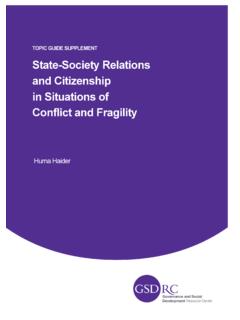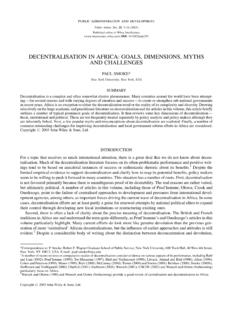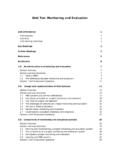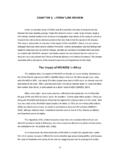Transcription of Quantitative and qualitative methods in impact …
1 Quantitative and qualitative methods in impact evaluation and Measuring Results Issues Paper Sabine Garbarino and Jeremy Holland March 2009. Quantitative and qualitative methods in impact evaluation and measuring results GSDRC Emerging Issues Research Service This Issues Paper was commissioned by the UK Department for International development (DFID) through the Emerging Issues Research Service of the Governance and Social development Resource Centre (GSDRC). The service addresses emerging priority agendas of concern to the international development community. For more information see ISBN 0 7044 2756 7 / 9780704427563. Social development Direct, 2009. i Quantitative and qualitative methods in impact evaluation and measuring results Acknowledgements We are grateful to colleagues in the Department for International development (DFID) and amongst the research and practitioner communities for their time and inputs to the development of this paper. This is a DFID/OPM/GSDRC study, which was commissioned by DFID.
2 The paper was produced by Sabine Garbarino and Jeremy Holland from Oxford Policy Management (OPM). We are grateful to colleagues in DFID for their expert insight and for providing material, resources and comments: Jane Hobson (Gender and Social Exclusion Workstream Leader, Equity and Rights Team), Sue Holloway (Deputy Chief Economist), Penny Innes (Senior Stats Adviser, Aid Effectiveness and Accountability Department), Rachael Beaven (Deputy Head of Profession, Statistics), Tim Robertson (Theme Leader for Governance, Social development , Humanitarian and Conflict), Sue Kinn (Research Manager, Central Research Department), Helen Wedgewood (Deputy Head, evaluation Department) and Ellen Wratten (Head of Profession, Social development ). We are specifically thankful to Jillian Popkins (Deputy Head of Profession Social development ) and Adrian Nembhard (Economist, evaluation Department) for the essential guidance and detailed comments on the draft report. Finally, we would like to thank all DFID staff, researchers and practitioners who participated in the workshop on 21 January 2009 and contributed to the revision of the paper through their comments and discussions.
3 Ii Quantitative and qualitative methods in impact evaluation and measuring results Contents Acknowledgements i List of tables and figures iv Abbreviations v Glossary of terms relating to impact (common and technical) vi 1 Introduction 1. 2 The policy context: Tackling the evaluation gap 3. From principles to practice 3. Challenges to doing more and better impact evaluations 4. Opportunities 5. 3 Quantitative and qualitative research: Clarifying the terminology 7. 4 Utilising Quantitative and qualitative approaches in impact evaluation 11. Combining methods in impact evaluation 12. Measuring qualitative impacts 14. 5 Operationalising combined methods for impact evaluation 18. 6 Concluding comments 27. Bibliography 29. Annex A Measuring qualitative impacts 34. Governance 34. Empowerment 35. Social capital 37. Social exclusion 40. iii Quantitative and qualitative methods in impact evaluation and measuring results List of tables and figures Table Empowerment scorecard results in the three research communities, Jamaica 17.
4 Table Using qualitative and combined approaches in impact evaluation : A checklist for DFID staff 24. Table Examples of open and closed questions to research social capital along five dimensions 39. Figure The method data framework 7. Figure qualitative and Quantitative dimensions of poverty appraisal 10. Box DFID policy paper: Guiding principles for impact evaluation 3. Box Combined methods in ex-post PSIA: Abolition of user fees in health units in Uganda 6. Box Participatory numbers and going to scale in Malawi 9. Box Participatory numbers: Opportunities and trade-offs 10. Box You can't carry electricity on boats: rural electrification in Lao PDR 13. Box Self-help groups in Andhra Pradesh 14. Box Community Score Cards 16. Box The Challenge of impact evaluation in fragile states: Thoughts from DRC 20. Box impact evaluation of the Ethiopia social protection programme 21. Box Consultative impact monitoring of policies (CoIMpact): qualitative impact Monitoring (QIM) in Malawi 22.
5 Box Key principles of good PSIA process 23. Box Measuring and analysing empowerment impacts: Social Safety Net Programs in Bangladesh 36. Box DFID's Gender and Social Exclusion Analysis (GSEA) 41. iv Quantitative and qualitative methods in impact evaluation and measuring results Abbreviations 3ie International Initiative for impact evaluation CGD Center for Global development CoIMpact Consultative impact monitoring of policies CRC Citizen Report Card CSC Community Score Card DAC development Assistance Committee DFID Department for International development GEM Gender Empowerment Measure GSEA Gender and Social Exclusion Analysis HDP Human development Project IFPRI International Food Policy Research Institute IMD Index of Multiple Deprivation NONIE Network of Networks on impact evaluation OECD Organisation for Economic Co-operation and development OPM Oxford Policy Management PPA Participatory Poverty Assessment PSIA Poverty and Social impact Analysis QIM qualitative impact Monitoring RCT Randomised Control Trial SCPS Social Capital and Poverty Survey SHGs Self-Help Groups UN United Nations UNDP United Nations development Programme v Quantitative and qualitative
6 methods in impact evaluation and measuring results Glossary of terms relating to impact (common and technical). Term Definition Accountability Obligations of partners to act according to clear defined responsibilities, roles and performance expectations, often with respect to the prudent use of resources particularly to taxpayers and citizens. Activity Actions taken or work performed through which inputs, such as funds, technical assistance and other types of resources are mobilised to produce specific outputs. Attribution Refers to that which is to be credited for the observed changes or results achieved. It represents the extent to which observed development effects can be attributed to a specific intervention or to the performance of one or more partners, taking account of other interventions (anticipated or unanticipated) confounding factors, or external shocks. Base-line Study An analysis describing the situation prior to a development intervention, against which progress can be assessed or comparisons made.
7 Beneficiaries The individuals, groups, or organizations, whether targeted or not, that benefit, directly or indirectly, from the development intervention. Counterfactual The situation or condition which hypothetically may prevail for individuals, organisations, or groups were there no development intervention. development Intervention An instrument for partner support aimed to promote development . Effect Intended or unintended change due directly or indirectly to an intervention. evaluation Assessment, as systematic and objective as possible, of ongoing or completed aid activities, their design, implementation and results. The aim is to determine the relevance and fulfilment of objectives, developmental efficiency, effectiveness, impact and sustainability. Goal The higher-order objective to which a development intervention is intended to contribute. impact The difference international aid makes to either indicators or (as used by people's lives; and having the ability to prove it.)
8 Management). impact Positive and negative, primary and secondary long-term effects (as used in evaluation ) produced by a development intervention, directly or indirectly, intended or unintended. Indicator Quantitative or qualitative factor or variable that provides a simple and reliable means to measure achievement, to reflect the changes connected to an intervention, or to help assess the performance of a development actor. Inputs The financial, human, and material resources used for the development intervention. Monitoring A continuing function that uses systematic collection of data on specified indicators to provide management and the main stakeholders of an ongoing development intervention with indications of the extent of progress and achievement of objectives vi Quantitative and qualitative methods in impact evaluation and measuring results Term Definition and progress in the use of allocated funds. Outcome The likely or achieved short-term and medium-term effects of an intervention's outputs.
9 Outputs The products, capital goods and services which result from a development intervention; may also include changes resulting from the intervention which are relevant to the achievement of outcomes Results Describing what has been achieved following the provision of international aid. Results Chain The causal sequence for a development intervention that stipulates the necessary sequence to achieve desired objectives beginning with inputs, moving through activities and outputs, and culminating in outcomes and impacts. Source: The glossary of terms is presented in the DFID Draft Policy Statement on impact evaluation and is based on OECD DAC ' evaluation of Key Terms in evaluation : Glossary of Key Terms in evaluation & Results Based Management' apart from ' impact ' (as used by Management) and evaluation ' which is taken from DFID's new economists guide (Brook at al 2006). vii Quantitative and qualitative methods in impact evaluation and measuring results 1 Introduction There has been a renewed interest in impact evaluation1 in recent years amongst development agencies and donors.
10 Additional attention was drawn to the issue recently by a Center for Global development (CGD) report calling for more rigorous impact evaluations, where rigorous' was taken to mean studies which tackle the selection bias aspect of the attribution problem (CGD, 2006). This argument was not universally well received in the development community; among other reasons there was the mistaken belief that supporters of rigorous impact evaluations were pushing for an approach solely based on randomised control trials (RCTs). While randomisers' have appeared to gain the upper hand in a lot of the debates particularly in the United States the CGD report in fact recognises a range of approaches and the entity set up as a results of its efforts, 3ie, is moving even more strongly towards mixed methods (White, nd). The Department for International development (DFID) in its draft policy statements similarly stresses the opportunities arising from a synthesis of qualitative and qualitative approaches in impact evaluation .












